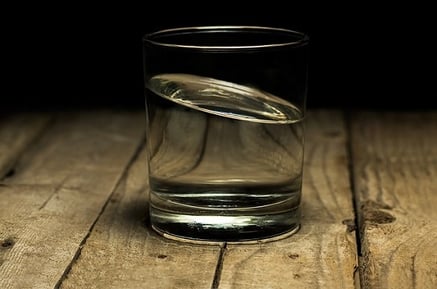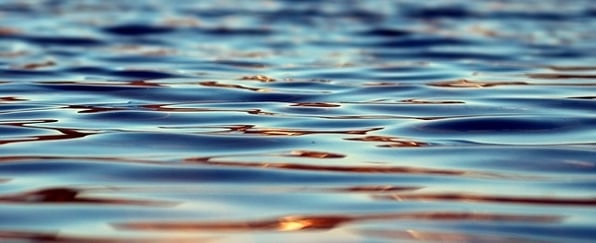Density Of Water In Kg/l
What is the density of h2o? Does information technology matter what the temperature is? How can you figure out the density of other objects and liquids? In this guide nosotros explicate h2o density, provide a chart you tin utilize to find the density of water at unlike temperatures, and explain three unlike ways to calculate density. Density is the mass per unit volume of a substance. The density of water is most given every bit 1 g/cm3, merely below is the density of water with dissimilar units. It's no coincidence that water has a density of i. Density is mass divided past book (ρ=grand/v), and water was used as the basis for establishing the metric unit of mass, which means a cubic centimeter (1cm3) of water weighs one gram (1g). So, 1g/1cm3 = i g/cmthree, giving water its like shooting fish in a barrel-to-remember density. However, water'south exact density depends on both the air pressure and the temperature of the expanse. These variations in density are very slight though, then unless you demand to know very verbal calculations or the experiment takes place in an area with an farthermost temperature/pressure level, you can continue to utilize 1 g/cmiii for water density. You lot tin can look at the chart in the next section to see how water's density changes with temperature. Note that these h2o density values are only true for pure h2o. Saltwater (like the oceans) has a different density which depends on how much salt is dissolved in the water. Seawater density is typically slightly higher than the density of pure water, about 1.02g/cm3 to one.03g/cmthree. Below is a chart that shows the density of water (in grams/cmiii) at different temperatures, ranging from beneath h2o'due south freezing bespeak (-22°F/-thirty°C) to its boiling point (212°F/100°C). As you can see in the chart, water but has an verbal density of ane g/cm3 at 39.2°F or iv.0°C. Once you get below h2o'due south freezing betoken (32°F/0°C), the density of water decreases considering water ice is less dense than water. This is why ice floats on tiptop of water and, when you put ice cubes in a glass of water, they don't just sink straight to the lesser. The chart as well shows that, for the range of temperatures typical for indoor science labs (virtually 50°F/10°C to 70°F/21°C), the density of water is very shut to one g/cmthree, which is why that value is used in all but the most exact density calculations. It's not until the temperature is very farthermost in one direction or some other (close to freezing or boiling), that the temperature of h2o changes enough that 1 g/cm3 would no longer be acceptably accurate. Source: USGS Then know you lot know what the density of h2o is at different temperatures, merely what if you lot desire to find the density of something that isn't h2o? Information technology's actually pretty like shooting fish in a barrel to exercise! You tin can discover the density of whatsoever substance by dividing its mass by its volume. The formula for density is: ρ=one thousand/v, with density represented past the symbol ρ (pronounced "rho"). There are iii main ways to calculate density, depending on whether you're trying to find the density of a regularly-shaped object, an irregular object, or a liquid, and if you take whatever special tools like a hydrometer. For regular objects (those whose faces are standard polygons, such as squares, rectangles, triangles, etc.) you can calculate mass and volume fairly easily. The mass of an object is simply how much information technology weighs, and all regular polygons have an equation for determining their volume based on their length, width, and elevation. For example, say y'all have a rectangular piece of aluminum that weighs 865g and has measurements of 10cm x 8cm x 4cm. First y'all'd find the volume of the piece of aluminum by multiplying the length, width, and pinnacle (which is the equation for volume of a rectangle). V = 10cm 10 8cm 10 4cm = 320 cm3 Adjacent, you lot divide the mass by the volume to go density (ρ=m/v). 865g/320cm3 = 2.7g/cmiii Then the density of aluminum is 2.7g/cmiii, and this is truthful for any piece of (pure and solid) aluminum, no thing what its size is. If the object has an irregular shape and y'all tin't easily calculate its volume, you can find its volume by placing it in a graduated cylinder filled with h2o and measuring the volume of water it displaces. Archimedes' Principle states that an object displaces a volume of liquid equal to its own volume. One time you have institute the volume, you'd use the standard ρ=m/v equation. So if you had a different, irregular piece of aluminum that weighed 550g and displaced 204mL of water in a graduated cylinder, and then your equation would be ρ = 550g/204mL = two.7g/mL. If the substance you're trying to find the density of is a liquid, y'all tin simply pour the liquid into the graduated cylinder and see what its volume is, then calculate density from there. If yous're trying to calculate the density of a liquid, y'all also can do and so by using an instrument known as a hydrometer. A hydrometer looks like a thermometer with a large bulb at i end to get in float. To utilise one, you merely gently lower the hydrometer into the liquid until the hydrometer is floating on its ain. Find which part of the hydrometer is right at the surface of the liquid and read the number on the side of the hydrometer. That'll exist the density. Hydrometers float lower in less dense liquids and higher in more dense liquids. Water density is typically rounded to ane chiliad/cmthree or 1000 kg/yard3, unless you are doing very exact calculations or conducting an experiment in extreme temperatures. Water'southward density changes depending on the temperature, so if yous're doing an experiment shut to or past water's boiling or freezing point, you'll demand to apply a different value to take into account the change in density. Both steam and ice are less dense than water. The equation for density is ρ=g/v. In order to measure the density of a substance, you can calculate a regularly-shaped object'south volume and proceed from there, measure out the book of a liquid or how much liquid an irregular object displaces in a graduated cylinder, or utilize a hydrometer to mensurate the density of a liquid. Now that y'all know why h2o's density is unique, but what about its other characteristics? Discover out why the specific heat of water is special. Looking for other physics-related topics? We'll teach y'all how to calculate acceleration with these three essential formulas and requite you lot ii simple examples of the police force of conservation of mass. Desire to know the fastest and easiest ways to convert between Fahrenheit and Celsius? We've got you covered! Check out our guide to the best ways to convert Celsius to Fahrenheit (or vice versa). Are you studying clouds in your scientific discipline class? Become help identifying the different types of clouds with our expert guide. Writing a enquiry paper for school but not certain what to write nigh? Our guide to inquiry newspaper topics has over 100 topics in ten categories so you can be sure to find the perfect topic for you lot. Demand more aid with this topic? Check out Tutorbase! Our vetted tutor database includes a range of experienced educators who tin can aid you polish an essay for English or explain how derivatives piece of work for Calculus. You tin can use dozens of filters and search criteria to find the perfect person for your needs. 
What Is the Density of Water?
Unit Water Density Density of water g/cm3 1 g/cmthree Density of water grand/mL ane g/mL Density of water kg/m3 thou kg/m3 Density of water lb/ftiii 62.iv lbs/ft3 Water Density at Different Temperatures
Temperature (°F/°C) Density of Water (grams/cm3) -22°/-xxx° 0.98385 -4°/-20° 0.99355 xiv°/-x° 0.99817 32°/0° 0.99987 39.2°/4.0° 1.00000 40°/iv.4° 0.99999 50°/10° 0.99975 60°/15.6° 0.99907 70°/21° 0.99802 lxxx°/26.seven° 0.99669 90°/32.two° 0.99510 100°/37.viii° 0.99318 120°/48.ix° 0.98870 140°/threescore° 0.98338 160°/71.ane° 0.97729 180°/82.2° 0.97056 200°/93.3° 0.96333 212°/100° 0.95865 
How to Summate the Density of a Substance
Calculating the Density of a Regular Object
Computing the Density of a Liquid or Irregular Object
Calculating the Density of a Liquid With a Hydrometer

Summary: What Is the Density of H2o?
What'south Next?


Near the Author
Christine graduated from Michigan State University with degrees in Ecology Biological science and Geography and received her Master's from Duke University. In high schoolhouse she scored in the 99th percentile on the SAT and was named a National Merit Finalist. She has taught English and biology in several countries.
Density Of Water In Kg/l,
Source: https://blog.prepscholar.com/what-is-the-density-of-water
Posted by: springerneigne.blogspot.com


0 Response to "Density Of Water In Kg/l"
Post a Comment